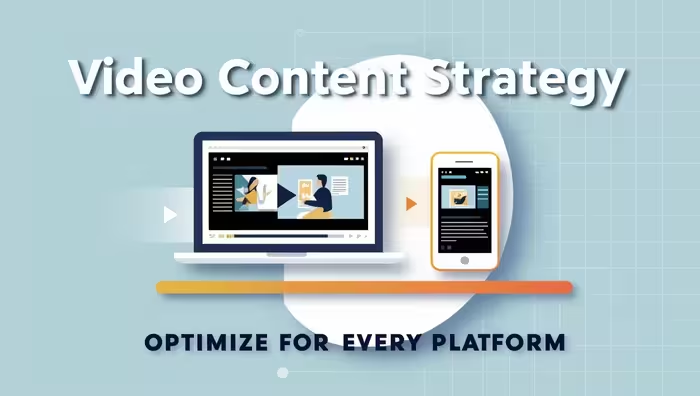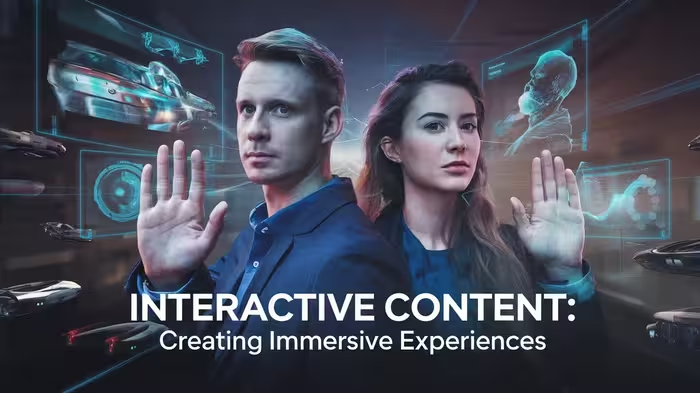In today’s digital landscape, video content reigns supreme. It’s the crown jewel of content marketing, captivating audiences across various platforms with its dynamic and engaging nature. But here’s the kicker: not all video platforms are created equal. Each has its own quirks, requirements, and audience expectations. So, how do you navigate this complex terrain and create a video content strategy that shines across different platforms? Buckle up, because we’re about to embark on a journey through the world of multi-platform video content strategy!
Understanding the Video Landscape
The Rise of Video Content
Let’s face it: video is no longer the future of content – it’s the present. With attention spans shrinking faster than a wool sweater in hot water, video has emerged as the perfect medium to capture and retain audience interest. But why has video content become such a big deal?
Imagine you’re at a bustling party. Amidst the chatter and music, someone starts telling a story with vivid gestures and expressions. Naturally, you’re drawn to them. That’s what video does in the digital space – it cuts through the noise and grabs attention like nothing else.
Platform Diversity and Its Challenges
Now, picture this party taking place simultaneously in different rooms, each with its own vibe and crowd. That’s the reality of today’s video platforms. You’ve got the cool kids hanging out on TikTok, the professionals networking on LinkedIn, and everyone in between scattered across YouTube, Instagram, and Facebook.
Each of these platforms is like a different language. What works in one might fall flat in another. It’s like trying to tell the same joke at a corporate meeting and a college dorm – you’d probably adjust your delivery, right? That’s the challenge (and the beauty) of crafting a video content strategy for different platforms.
Key Video Platforms and Their Unique Requirements
YouTube: The Video Giant
YouTube is the granddaddy of video platforms. It’s like the Swiss Army knife of video content – versatile, reliable, and always there when you need it. But what makes YouTube tick?
- Length Flexibility: From quick tutorials to feature-length documentaries, YouTube welcomes it all.
- SEO Importance: YouTube is the second largest search engine. Keywords, titles, and descriptions matter – a lot.
- Audience Retention: The algorithm favors videos that keep viewers watching. Hook them early and keep them engaged!
Think of YouTube as a library where your videos are books. You want them to be discoverable, engaging, and worth the time investment.
Instagram: Visual Storytelling
Instagram is the cool, artsy cousin in the video platform family. It’s where aesthetics meet storytelling. With features like Reels, IGTV, and Stories, Instagram offers a buffet of video options.
- Visual Appeal: Your videos need to stop the scroll. Think eye-catching and visually stunning.
- Short and Sweet: Reels cap at 60 seconds, Stories at 15 seconds. It’s all about quick, impactful content.
- Authenticity: Behind-the-scenes, raw moments, and genuine interactions thrive here.
Imagine Instagram as a glossy magazine. Your videos should be like those captivating images that make you pause and take a closer look.
TikTok: Short-Form Creativity
TikTok is the new kid on the block that’s taken the world by storm. It’s fast-paced, trend-driven, and all about creative expression.
- Brevity is Key: Videos are capped at 3 minutes, but the sweet spot is often much shorter.
- Trend Participation: Jumping on trends and challenges can skyrocket your visibility.
- Sound Matters: Music and audio play a crucial role in TikTok content.
Think of TikTok as a talent show where everyone gets 15 seconds to impress. How will you make your mark?
Facebook: Social Video Engagement
Facebook is like the town square of the internet – it’s where everyone gathers. Video content here needs to foster connection and conversation.
- Shareability: Create content that people want to share with their friends and family.
- Silent Viewing: Many users watch without sound, so captions are crucial.
- Live Video: Facebook Live is a powerful tool for real-time engagement.
Imagine Facebook as a community bulletin board. Your videos should be like those notices that get people talking and sharing.
LinkedIn: Professional Video Content
LinkedIn is where the professionals hang out. It’s suits, ties, and… videos? Absolutely!
- Educational Content: Think how-tos, industry insights, and thought leadership.
- Polish and Professionalism: While authenticity matters, a certain level of polish is expected.
- Shorter is Better: Aim for 1-2 minutes to keep busy professionals engaged.
Picture LinkedIn as a business conference. Your videos should be like those presentations that leave everyone inspired and informed.
Crafting a Multi-Platform Video Strategy
Defining Your Video Content Goals
Before you start creating videos left and right, take a step back. What are you trying to achieve? Are you looking to increase brand awareness, drive sales, educate your audience, or maybe all of the above?
Your goals will be your North Star, guiding every video you create. Without clear goals, you’re like a ship without a compass – you might move, but you won’t know if you’re going in the right direction.
Identifying Your Target Audience
Who are you making these videos for? Knowing your audience is like having a secret weapon. It helps you speak their language, address their pain points, and create content that resonates.
Create audience personas for each platform. The professional looking for industry insights on LinkedIn is probably in a different headspace than the teen scrolling through TikTok for entertainment.
Creating a Content Calendar
A content calendar is your roadmap to video success. It’s like meal prepping for your content strategy – you plan ahead, so you’re not scrambling at the last minute.
- Plan for platform-specific content
- Account for seasonal trends and events
- Balance different types of videos (educational, entertaining, promotional)
Remember, consistency is key. A steady stream of quality content keeps your audience coming back for more.
Adapting Content for Different Platforms
Optimizing Video Length
Video length isn’t one-size-fits-all. It’s more like choosing the right tool for the job. You wouldn’t use a sledgehammer to hang a picture frame, right?
- TikTok and Instagram Reels: 15-60 seconds
- Instagram Stories: 15 seconds per segment
- YouTube: 10 minutes+ for in-depth content
- Facebook: 1-3 minutes for optimal engagement
- LinkedIn: 1-2 minutes for professional audiences
The key is to respect your audience’s time while delivering value. Can you get your message across in 30 seconds? Great! Need 10 minutes to dive deep? That’s fine too, if the platform and content warrant it.
Tailoring Aspect Ratios
Aspect ratio is like choosing the right outfit for different occasions. You wouldn’t wear a tuxedo to the beach, would you?
- Vertical (9:16): Perfect for TikTok, Instagram Stories, and Reels
- Square (1:1): Great for Instagram feed posts and Facebook
- Horizontal (16:9): Ideal for YouTube and LinkedIn
Pro tip: When creating content, shoot in high resolution with extra space around your subject. This gives you flexibility to crop for different platforms without reshooting.
Adjusting Content Style and Tone
Each platform has its own vibe, and your content should match it. It’s like code-switching in conversations – you probably speak differently with your boss than with your best friend.
- TikTok: Fun, trendy, and often humorous
- Instagram: Visually appealing and lifestyle-oriented
- YouTube: Informative and entertaining
- Facebook: Relatable and shareable
- LinkedIn: Professional and insightful
The key is to maintain your brand voice while adapting to the platform’s culture. It’s a balancing act, but get it right, and you’ll connect with your audience on a deeper level.
Technical Considerations
Video Quality and Resolution
In the world of video, quality matters. It’s like the difference between a gourmet meal and fast food – both might satisfy hunger, but the experience is vastly different.
- Aim for at least 1080p resolution for most platforms
- Consider 4K for YouTube if your content warrants it
- Ensure good lighting and clear audio – these can make or break a video
Remember, your video quality reflects your brand quality. Don’t let technical issues overshadow your message.
Audio Requirements
Good audio is the unsung hero of great videos. It’s like salt in cooking – you might not notice it when it’s there, but you definitely notice when it’s missing.
- Use external microphones for better sound quality
- Be mindful of background noise
- Consider adding background music to set the mood (but be careful with copyright!)
For platforms like Facebook, where videos often play without sound, ensure your message comes across visually too.
Captions and Subtitles
Captions are like the safety net of video content. They catch viewers who might otherwise slip away due to audio issues or language barriers.
- Always include captions for accessibility
- Use platform-specific caption tools where available
- Consider translating captions for international audiences
Plus, captions improve SEO, making your videos more discoverable. It’s a win-win!
Engaging Your Audience Across Platforms
Platform-Specific Features and Trends
Each platform has its own set of toys in the sandbox. Play with them! It’s like learning the local customs when you visit a new country – it shows you’re making an effort to fit in.
- Use hashtag challenges on TikTok
- Leverage Instagram’s interactive stickers in Stories
- Create playlists on YouTube to keep viewers watching
- Use Facebook’s polling feature to boost engagement
Staying on top of platform trends is like surfing – catch the wave at the right time, and you’ll ride it to success.
Encouraging User Interaction
Don’t just talk at your audience – talk with them. It’s the difference between a lecture and a conversation.
- Ask questions in your videos
- Encourage comments and respond to them
- Create content that invites user-generated responses
Think of your video content as the opening line in a dialogue. What response do you want to elicit?
Leveraging Cross-Platform Promotion
Your video strategy shouldn’t exist in silos. Think of it as an ecosystem where each platform supports the others.
- Tease YouTube content with short clips on Instagram
- Share behind-the-scenes content on TikTok
- Repurpose LinkedIn video insights for Facebook
It’s like being the host of a party where all your friends from different circles are invited. Help them mingle and get to know each other!
Measuring Success and Iterating
Key Performance Indicators (KPIs) for Video Content
Measuring success in video content is like checking the scoreboard in a game. It tells you if you’re winning or if you need to change your strategy.
- Views and Watch Time: How many people are watching and for how long?
- Engagement Rate: Are people liking, commenting, and sharing?
- Click-Through Rate: Is your video driving action?
- Follower Growth: Is your content attracting new audience members?
Remember, different goals require different metrics. A viral TikTok might get tons of views, but a LinkedIn video might be more successful with fewer views but higher-quality leads.
Analytics Tools for Different Platforms
Each platform offers its own analytics tools, like different instruments in an orchestra. Learning to play them all gives you a fuller picture of your performance.
- YouTube Analytics for detailed audience insights
- Instagram Insights for Stories and Reels performance
- TikTok Analytics for trend performance
- Facebook Insights for engagement metrics
- LinkedIn Analytics for professional audience data
Combine these platform-specific insights with third-party tools for a comprehensive view of your video performance across the board.
A/B Testing and Content Refinement
Don’t be afraid to experiment! A/B testing in video content is like being a chef who’s always tweaking recipes. Try different:
- Thumbnails and cover images
- Video lengths
- Call-to-actions
- Content styles and formats
Use the data from these tests to refine your strategy. What works well on one platform might bomb on another. That’s okay! It’s all part of the learning process.
Future Trends in Video Content Strategy
As we wrap up our journey through the world of multi-platform video content strategy, let’s gaze into the crystal ball. What does the future hold?
- Increased use of AI in video creation and optimization
- Growth of interactive and shoppable video content
- Rise of augmented reality (AR) in video experiences
- Continued dominance of short-form, snackable content
- Greater emphasis on authenticity and raw, unpolished videos
The key to staying ahead? Adaptability. The video landscape is like a river – always flowing, always changing. Stay curious, keep learning, and be ready to pivot when new platforms or trends emerge.
Conclusion
Crafting a video content strategy for different platforms is no small feat. It’s a delicate balance of creativity, strategy, and technical know-how. But get it right, and you’ll have a powerful tool to connect with your audience, wherever they are.
Remember, there’s no one-size-fits-all approach. What works for one brand might not work for another. The key is to know your audience, understand the platforms, and stay true to your brand voice. Keep experimenting, analyzing, and refining your approach.
Video content is not just the future – it’s the now. So grab your camera, fire up those editing tools, and start creating. Your audience is waiting!
FAQs
- Q: How often should I post video content on different platforms?
A: Frequency depends on your resources and audience, but aim for consistency. For example, you might post daily on TikTok, weekly on YouTube, and 2-3 times a week on Instagram and Facebook. The key is to maintain quality while being consistent. - Q: Should I create separate videos for each platform or repurpose content?
A: A mix of both is ideal. Create platform-specific content to leverage each platform’s unique features, but also repurpose content smartly to maximize efficiency. Just ensure you adapt the content to fit each platform’s requirements and audience expectations. - Q: How do I make my videos stand out in a crowded digital space?
A: Focus on providing value, whether through education, entertainment, or inspiration. Develop a unique brand voice, stay on top of trends, and don’t be afraid to innovate. Most importantly, know your audience and create content that resonates with them specifically. - Q: What equipment do I need to create high-quality videos for different platforms?
A: You can start with a smartphone, good lighting, and a basic microphone. As you grow, you might invest in a DSLR or mirrorless camera, professional lighting setup, and editing software. Remember, content quality often matters more than production quality, especially when you’re starting out. - Q: How can I measure the ROI of my video content strategy across different platforms?
A: Track platform-specific metrics (views, engagement, etc.) alongside broader business KPIs like website traffic, lead generation, or sales attributed to video content. Use UTM parameters for links in your videos to track traffic sources. Ultimately, align your metrics with your overall business goals to get a true picture of ROI.


